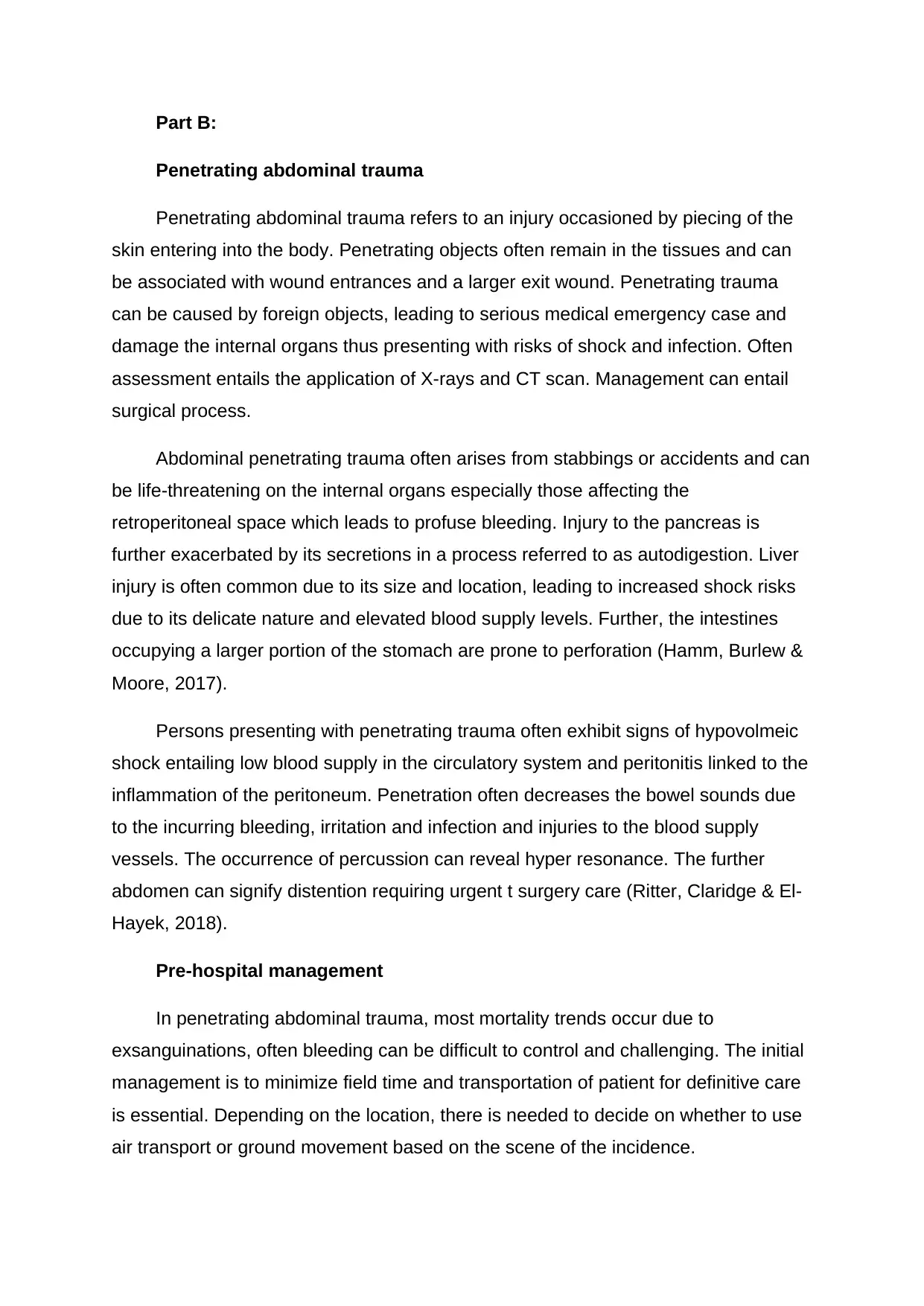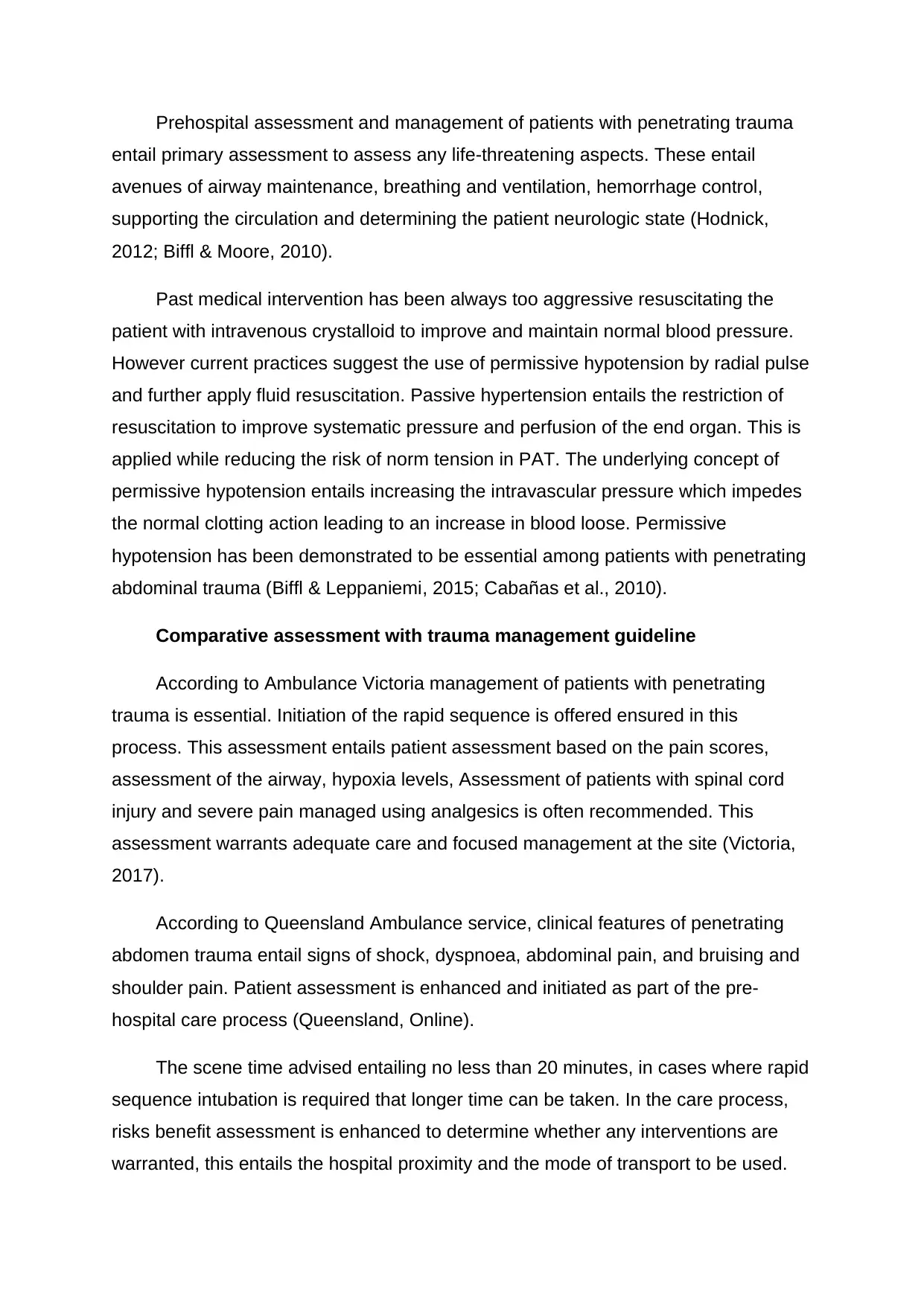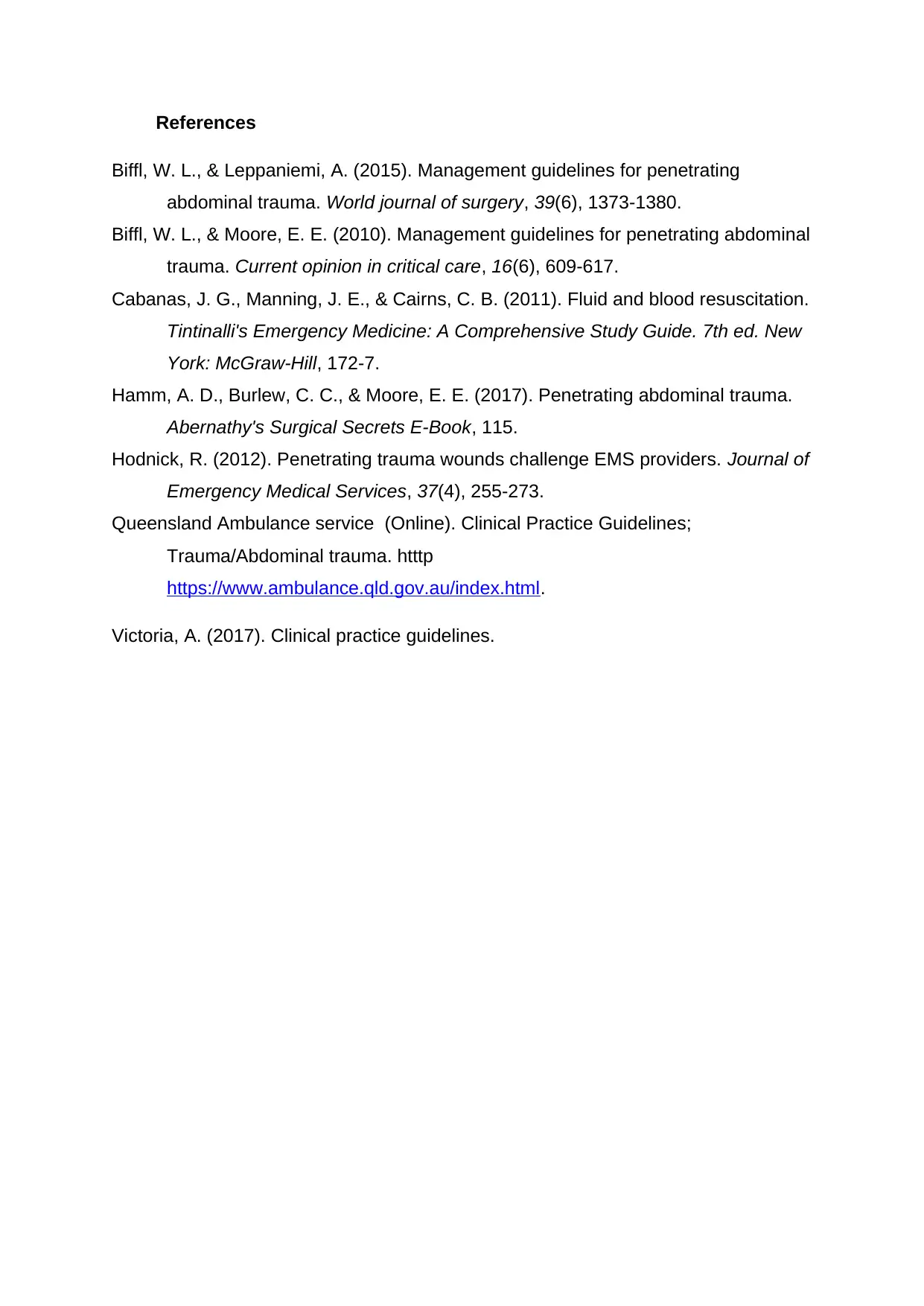University Paramedic Studies: Penetrating Abdominal Trauma Case Study
VerifiedAdded on 2022/09/26
|5
|1152
|13
Essay
AI Summary
This essay is a case study focused on penetrating abdominal trauma, designed for paramedics. It examines the nature of penetrating abdominal injuries, including the mechanisms of injury, potential complications, and the importance of rapid assessment. The essay details pre-hospital management strategies, emphasizing the significance of controlling hemorrhage, maintaining the airway, and supporting circulation. It explores the concept of permissive hypotension and its role in managing these types of injuries. Furthermore, the essay compares and contrasts the guidelines and protocols for managing penetrating abdominal trauma from Ambulance Victoria and Queensland Ambulance Service, highlighting key differences in assessment and care. The study emphasizes the critical need for efficient and effective pre-hospital care to improve patient outcomes and discusses the importance of critical assessment and pre-hospital care which emphasizes patient stability before the hospital.

Trauma Studies for Paramedics
Case Study Assessment
University
Name
Case Study Assessment
University
Name
Paraphrase This Document
Need a fresh take? Get an instant paraphrase of this document with our AI Paraphraser

Part B:
Penetrating abdominal trauma
Penetrating abdominal trauma refers to an injury occasioned by piecing of the
skin entering into the body. Penetrating objects often remain in the tissues and can
be associated with wound entrances and a larger exit wound. Penetrating trauma
can be caused by foreign objects, leading to serious medical emergency case and
damage the internal organs thus presenting with risks of shock and infection. Often
assessment entails the application of X-rays and CT scan. Management can entail
surgical process.
Abdominal penetrating trauma often arises from stabbings or accidents and can
be life-threatening on the internal organs especially those affecting the
retroperitoneal space which leads to profuse bleeding. Injury to the pancreas is
further exacerbated by its secretions in a process referred to as autodigestion. Liver
injury is often common due to its size and location, leading to increased shock risks
due to its delicate nature and elevated blood supply levels. Further, the intestines
occupying a larger portion of the stomach are prone to perforation (Hamm, Burlew &
Moore, 2017).
Persons presenting with penetrating trauma often exhibit signs of hypovolmeic
shock entailing low blood supply in the circulatory system and peritonitis linked to the
inflammation of the peritoneum. Penetration often decreases the bowel sounds due
to the incurring bleeding, irritation and infection and injuries to the blood supply
vessels. The occurrence of percussion can reveal hyper resonance. The further
abdomen can signify distention requiring urgent t surgery care (Ritter, Claridge & El-
Hayek, 2018).
Pre-hospital management
In penetrating abdominal trauma, most mortality trends occur due to
exsanguinations, often bleeding can be difficult to control and challenging. The initial
management is to minimize field time and transportation of patient for definitive care
is essential. Depending on the location, there is needed to decide on whether to use
air transport or ground movement based on the scene of the incidence.
Penetrating abdominal trauma
Penetrating abdominal trauma refers to an injury occasioned by piecing of the
skin entering into the body. Penetrating objects often remain in the tissues and can
be associated with wound entrances and a larger exit wound. Penetrating trauma
can be caused by foreign objects, leading to serious medical emergency case and
damage the internal organs thus presenting with risks of shock and infection. Often
assessment entails the application of X-rays and CT scan. Management can entail
surgical process.
Abdominal penetrating trauma often arises from stabbings or accidents and can
be life-threatening on the internal organs especially those affecting the
retroperitoneal space which leads to profuse bleeding. Injury to the pancreas is
further exacerbated by its secretions in a process referred to as autodigestion. Liver
injury is often common due to its size and location, leading to increased shock risks
due to its delicate nature and elevated blood supply levels. Further, the intestines
occupying a larger portion of the stomach are prone to perforation (Hamm, Burlew &
Moore, 2017).
Persons presenting with penetrating trauma often exhibit signs of hypovolmeic
shock entailing low blood supply in the circulatory system and peritonitis linked to the
inflammation of the peritoneum. Penetration often decreases the bowel sounds due
to the incurring bleeding, irritation and infection and injuries to the blood supply
vessels. The occurrence of percussion can reveal hyper resonance. The further
abdomen can signify distention requiring urgent t surgery care (Ritter, Claridge & El-
Hayek, 2018).
Pre-hospital management
In penetrating abdominal trauma, most mortality trends occur due to
exsanguinations, often bleeding can be difficult to control and challenging. The initial
management is to minimize field time and transportation of patient for definitive care
is essential. Depending on the location, there is needed to decide on whether to use
air transport or ground movement based on the scene of the incidence.

Prehospital assessment and management of patients with penetrating trauma
entail primary assessment to assess any life-threatening aspects. These entail
avenues of airway maintenance, breathing and ventilation, hemorrhage control,
supporting the circulation and determining the patient neurologic state (Hodnick,
2012; Biffl & Moore, 2010).
Past medical intervention has been always too aggressive resuscitating the
patient with intravenous crystalloid to improve and maintain normal blood pressure.
However current practices suggest the use of permissive hypotension by radial pulse
and further apply fluid resuscitation. Passive hypertension entails the restriction of
resuscitation to improve systematic pressure and perfusion of the end organ. This is
applied while reducing the risk of norm tension in PAT. The underlying concept of
permissive hypotension entails increasing the intravascular pressure which impedes
the normal clotting action leading to an increase in blood loose. Permissive
hypotension has been demonstrated to be essential among patients with penetrating
abdominal trauma (Biffl & Leppaniemi, 2015; Cabañas et al., 2010).
Comparative assessment with trauma management guideline
According to Ambulance Victoria management of patients with penetrating
trauma is essential. Initiation of the rapid sequence is offered ensured in this
process. This assessment entails patient assessment based on the pain scores,
assessment of the airway, hypoxia levels, Assessment of patients with spinal cord
injury and severe pain managed using analgesics is often recommended. This
assessment warrants adequate care and focused management at the site (Victoria,
2017).
According to Queensland Ambulance service, clinical features of penetrating
abdomen trauma entail signs of shock, dyspnoea, abdominal pain, and bruising and
shoulder pain. Patient assessment is enhanced and initiated as part of the pre-
hospital care process (Queensland, Online).
The scene time advised entailing no less than 20 minutes, in cases where rapid
sequence intubation is required that longer time can be taken. In the care process,
risks benefit assessment is enhanced to determine whether any interventions are
warranted, this entails the hospital proximity and the mode of transport to be used.
entail primary assessment to assess any life-threatening aspects. These entail
avenues of airway maintenance, breathing and ventilation, hemorrhage control,
supporting the circulation and determining the patient neurologic state (Hodnick,
2012; Biffl & Moore, 2010).
Past medical intervention has been always too aggressive resuscitating the
patient with intravenous crystalloid to improve and maintain normal blood pressure.
However current practices suggest the use of permissive hypotension by radial pulse
and further apply fluid resuscitation. Passive hypertension entails the restriction of
resuscitation to improve systematic pressure and perfusion of the end organ. This is
applied while reducing the risk of norm tension in PAT. The underlying concept of
permissive hypotension entails increasing the intravascular pressure which impedes
the normal clotting action leading to an increase in blood loose. Permissive
hypotension has been demonstrated to be essential among patients with penetrating
abdominal trauma (Biffl & Leppaniemi, 2015; Cabañas et al., 2010).
Comparative assessment with trauma management guideline
According to Ambulance Victoria management of patients with penetrating
trauma is essential. Initiation of the rapid sequence is offered ensured in this
process. This assessment entails patient assessment based on the pain scores,
assessment of the airway, hypoxia levels, Assessment of patients with spinal cord
injury and severe pain managed using analgesics is often recommended. This
assessment warrants adequate care and focused management at the site (Victoria,
2017).
According to Queensland Ambulance service, clinical features of penetrating
abdomen trauma entail signs of shock, dyspnoea, abdominal pain, and bruising and
shoulder pain. Patient assessment is enhanced and initiated as part of the pre-
hospital care process (Queensland, Online).
The scene time advised entailing no less than 20 minutes, in cases where rapid
sequence intubation is required that longer time can be taken. In the care process,
risks benefit assessment is enhanced to determine whether any interventions are
warranted, this entails the hospital proximity and the mode of transport to be used.
⊘ This is a preview!⊘
Do you want full access?
Subscribe today to unlock all pages.

Trusted by 1+ million students worldwide

Further at the scene, considerations such as the number of patients, versus the
resources available for and time to hospital is essential.
Initiation of ARV notifications is essential to assess if the patient has to be
taken by ambulance to a hospital other than MTS. In this case, Ambulance Victoria
offers notification to ARV who will contact the primary receiving hospital within one
hour to determine the support and care needed.
Based on studies undertaken, patient management in penetrating trauma of the
abdominal requires an assessment for hemodynamic instability, evisceration, GI
bleeding; peritoneal signs and any other complications need to undergo emergency
care. Initial care process necessitates for airway assessment, cardiac rhythm
assessment, vital signs intake, history physical assessments and the need for the
placement of the intravenous lines. This step will allow for patient assessment as
transfer to primary hospital is being activated.
Despite the recommendations of care offered by Queensland Ambulance
Service (QAS) and Ambulance Victoria (AV), there is a need for critical assessment
and pre-hospital care which emphasizes patient stability before the hospital. The
guidelines do not offer an explicit care process and approach during on-site patient
care. Studies shave demonstrated an initial examination based on the primary
survey entailing the basic ABCDEs for the patient.
resources available for and time to hospital is essential.
Initiation of ARV notifications is essential to assess if the patient has to be
taken by ambulance to a hospital other than MTS. In this case, Ambulance Victoria
offers notification to ARV who will contact the primary receiving hospital within one
hour to determine the support and care needed.
Based on studies undertaken, patient management in penetrating trauma of the
abdominal requires an assessment for hemodynamic instability, evisceration, GI
bleeding; peritoneal signs and any other complications need to undergo emergency
care. Initial care process necessitates for airway assessment, cardiac rhythm
assessment, vital signs intake, history physical assessments and the need for the
placement of the intravenous lines. This step will allow for patient assessment as
transfer to primary hospital is being activated.
Despite the recommendations of care offered by Queensland Ambulance
Service (QAS) and Ambulance Victoria (AV), there is a need for critical assessment
and pre-hospital care which emphasizes patient stability before the hospital. The
guidelines do not offer an explicit care process and approach during on-site patient
care. Studies shave demonstrated an initial examination based on the primary
survey entailing the basic ABCDEs for the patient.
Paraphrase This Document
Need a fresh take? Get an instant paraphrase of this document with our AI Paraphraser

References
Biffl, W. L., & Leppaniemi, A. (2015). Management guidelines for penetrating
abdominal trauma. World journal of surgery, 39(6), 1373-1380.
Biffl, W. L., & Moore, E. E. (2010). Management guidelines for penetrating abdominal
trauma. Current opinion in critical care, 16(6), 609-617.
Cabanas, J. G., Manning, J. E., & Cairns, C. B. (2011). Fluid and blood resuscitation.
Tintinalli's Emergency Medicine: A Comprehensive Study Guide. 7th ed. New
York: McGraw-Hill, 172-7.
Hamm, A. D., Burlew, C. C., & Moore, E. E. (2017). Penetrating abdominal trauma.
Abernathy's Surgical Secrets E-Book, 115.
Hodnick, R. (2012). Penetrating trauma wounds challenge EMS providers. Journal of
Emergency Medical Services, 37(4), 255-273.
Queensland Ambulance service (Online). Clinical Practice Guidelines;
Trauma/Abdominal trauma. htttp
https://www.ambulance.qld.gov.au/index.html.
Victoria, A. (2017). Clinical practice guidelines.
Biffl, W. L., & Leppaniemi, A. (2015). Management guidelines for penetrating
abdominal trauma. World journal of surgery, 39(6), 1373-1380.
Biffl, W. L., & Moore, E. E. (2010). Management guidelines for penetrating abdominal
trauma. Current opinion in critical care, 16(6), 609-617.
Cabanas, J. G., Manning, J. E., & Cairns, C. B. (2011). Fluid and blood resuscitation.
Tintinalli's Emergency Medicine: A Comprehensive Study Guide. 7th ed. New
York: McGraw-Hill, 172-7.
Hamm, A. D., Burlew, C. C., & Moore, E. E. (2017). Penetrating abdominal trauma.
Abernathy's Surgical Secrets E-Book, 115.
Hodnick, R. (2012). Penetrating trauma wounds challenge EMS providers. Journal of
Emergency Medical Services, 37(4), 255-273.
Queensland Ambulance service (Online). Clinical Practice Guidelines;
Trauma/Abdominal trauma. htttp
https://www.ambulance.qld.gov.au/index.html.
Victoria, A. (2017). Clinical practice guidelines.
1 out of 5
Related Documents
Your All-in-One AI-Powered Toolkit for Academic Success.
+13062052269
info@desklib.com
Available 24*7 on WhatsApp / Email
![[object Object]](/_next/static/media/star-bottom.7253800d.svg)
Unlock your academic potential
Copyright © 2020–2025 A2Z Services. All Rights Reserved. Developed and managed by ZUCOL.





